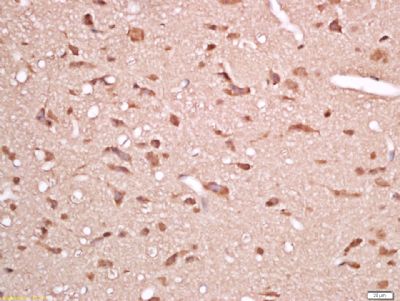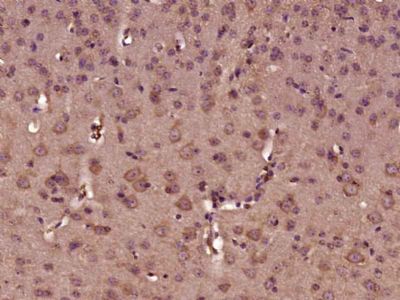ENPP6 Polyclonal Antibody
Purified Rabbit Polyclonal Antibody (Pab)
- SPECIFICATION
- CITATIONS
- PROTOCOLS
- BACKGROUND

Application
| WB, IHC-P, IHC-F, IF, ICC, E |
|---|---|
| Primary Accession | Q6UWR7 |
| Reactivity | Rat, Pig, Dog, Bovine |
| Host | Rabbit |
| Clonality | Polyclonal |
| Calculated MW | 46 KDa |
| Physical State | Liquid |
| Immunogen | KLH conjugated synthetic peptide derived from human ENPP6 |
| Epitope Specificity | 251-350/440 |
| Isotype | IgG |
| Purity | affinity purified by Protein A |
| Buffer | 0.01M TBS (pH7.4) with 1% BSA, 0.02% Proclin300 and 50% Glycerol. |
| SUBCELLULAR LOCATION | Cell membrane; Single-pass type I membrane protein. Secreted. Note: A minor secreted form also exists. |
| SIMILARITY | Belongs to the nucleotide pyrophosphatase/phosphodiesterase family. |
| SUBUNIT | Homodimer; disulfide-linked. |
| Important Note | This product as supplied is intended for research use only, not for use in human, therapeutic or diagnostic applications. |
| Background Descriptions | NPP6 is a 440 amino acid member of the nucleotide pyrophosphatase/phosphodiesterase family. NPP6 is a secreted and single-pass type I membrane protein. Predominantly expressed in brain and kidney, NPP6 is a choline-specific glycerophosphodiester phosphodiesterase. NPP6 can hydrolyze the classical substrate for phospholipase C, p-nitrophenyl phosphorylcholine, glycerophosphorylcholine, sphingosylphosphorylcholine and lysophosphatidylcholine (LPC). NPP6 has been found to have a preference for LPC with polyunsaturated or short fatty acids. The gene encoding NPP6 maps to human chromosome 4, which consists of approximately 6% of the human genome and nearly 900 genes. Chromosome 4 is associated with Huntington's disease, FGFR-3, Ellis-van Creveld syndrome, methylmalonic acidemia and polycystic kidney disease. |
| Gene ID | 133121 |
|---|---|
| Other Names | Glycerophosphocholine cholinephosphodiesterase ENPP6, GPC-Cpde, 3.1.4.-, 3.1.4.38, Choline-specific glycerophosphodiester phosphodiesterase, Ectonucleotide pyrophosphatase/phosphodiesterase family member 6, E-NPP 6, NPP-6, ENPP6 (HGNC:23409) |
| Target/Specificity | Predominantly expressed in kidney and brain. In the kidney, expressed specifically in the proximal tubules and thin descending limbs of Henle (at protein level). |
| Dilution | WB=1:500-2000,IHC-P=1:100-500,IHC-F=1:100-500,ICC=1:100-500,IF=1:100-500,ELISA=1:5000-10000 |
| Storage | Store at -20 ℃ for one year. Avoid repeated freeze/thaw cycles. When reconstituted in sterile pH 7.4 0.01M PBS or diluent of antibody the antibody is stable for at least two weeks at 2-4 ℃. |
| Name | ENPP6 (HGNC:23409) |
|---|---|
| Function | Choline-specific glycerophosphodiesterase that hydrolyzes glycerophosphocholine (GPC) and lysophosphatidylcholine (LPC) and contributes to supplying choline to the cells (PubMed:15788404). Has a preference for LPC with short (12:0 and 14:0) or polyunsaturated (18:2 and 20:4) fatty acids. In vitro, hydrolyzes only choline-containing lysophospholipids, such as sphingosylphosphorylcholine (SPC), platelet- activating factor (PAF) and lysoPAF, but not other lysophospholipids (By similarity). |
| Cellular Location | Cell membrane; Lipid-anchor, GPI-anchor. Note=A small amount of the protein may be found in the extracellular milieu |
| Tissue Location | Predominantly expressed in kidney and brain. In the kidney, expressed specifically in the proximal tubules and thin descending limbs of Henle (at protein level) |

Thousands of laboratories across the world have published research that depended on the performance of antibodies from Abcepta to advance their research. Check out links to articles that cite our products in major peer-reviewed journals, organized by research category.
info@abcepta.com, and receive a free "I Love Antibodies" mug.
Provided below are standard protocols that you may find useful for product applications.
If you have used an Abcepta product and would like to share how it has performed, please click on the "Submit Review" button and provide the requested information. Our staff will examine and post your review and contact you if needed.
If you have any additional inquiries please email technical services at tech@abcepta.com.













 Foundational characteristics of cancer include proliferation, angiogenesis, migration, evasion of apoptosis, and cellular immortality. Find key markers for these cellular processes and antibodies to detect them.
Foundational characteristics of cancer include proliferation, angiogenesis, migration, evasion of apoptosis, and cellular immortality. Find key markers for these cellular processes and antibodies to detect them. The SUMOplot™ Analysis Program predicts and scores sumoylation sites in your protein. SUMOylation is a post-translational modification involved in various cellular processes, such as nuclear-cytosolic transport, transcriptional regulation, apoptosis, protein stability, response to stress, and progression through the cell cycle.
The SUMOplot™ Analysis Program predicts and scores sumoylation sites in your protein. SUMOylation is a post-translational modification involved in various cellular processes, such as nuclear-cytosolic transport, transcriptional regulation, apoptosis, protein stability, response to stress, and progression through the cell cycle. The Autophagy Receptor Motif Plotter predicts and scores autophagy receptor binding sites in your protein. Identifying proteins connected to this pathway is critical to understanding the role of autophagy in physiological as well as pathological processes such as development, differentiation, neurodegenerative diseases, stress, infection, and cancer.
The Autophagy Receptor Motif Plotter predicts and scores autophagy receptor binding sites in your protein. Identifying proteins connected to this pathway is critical to understanding the role of autophagy in physiological as well as pathological processes such as development, differentiation, neurodegenerative diseases, stress, infection, and cancer.




